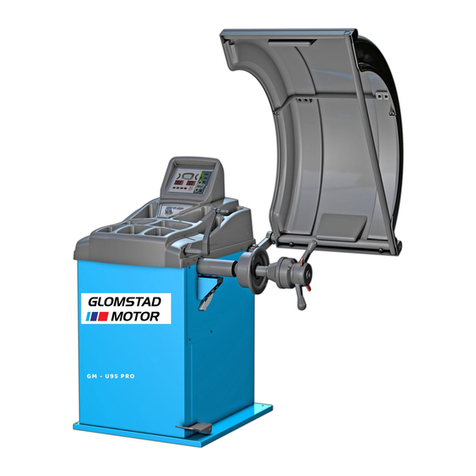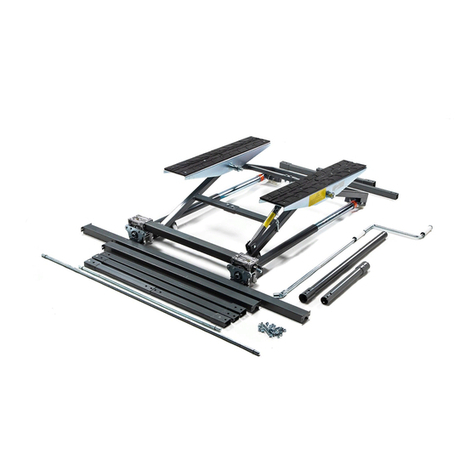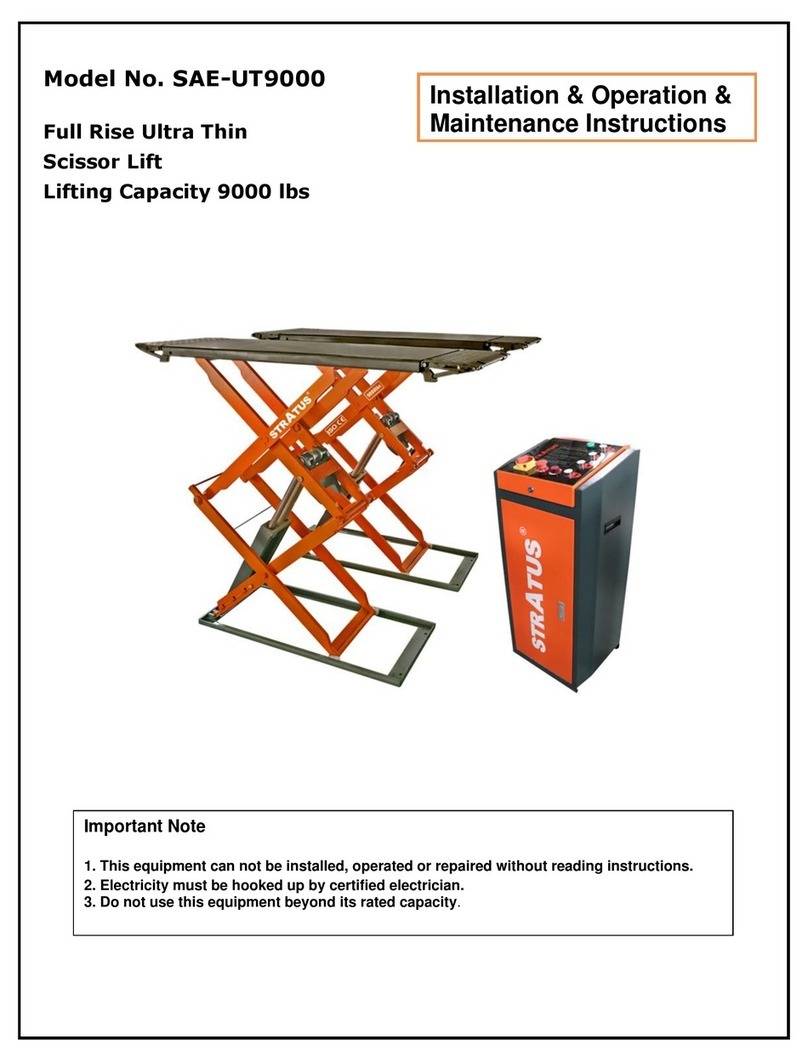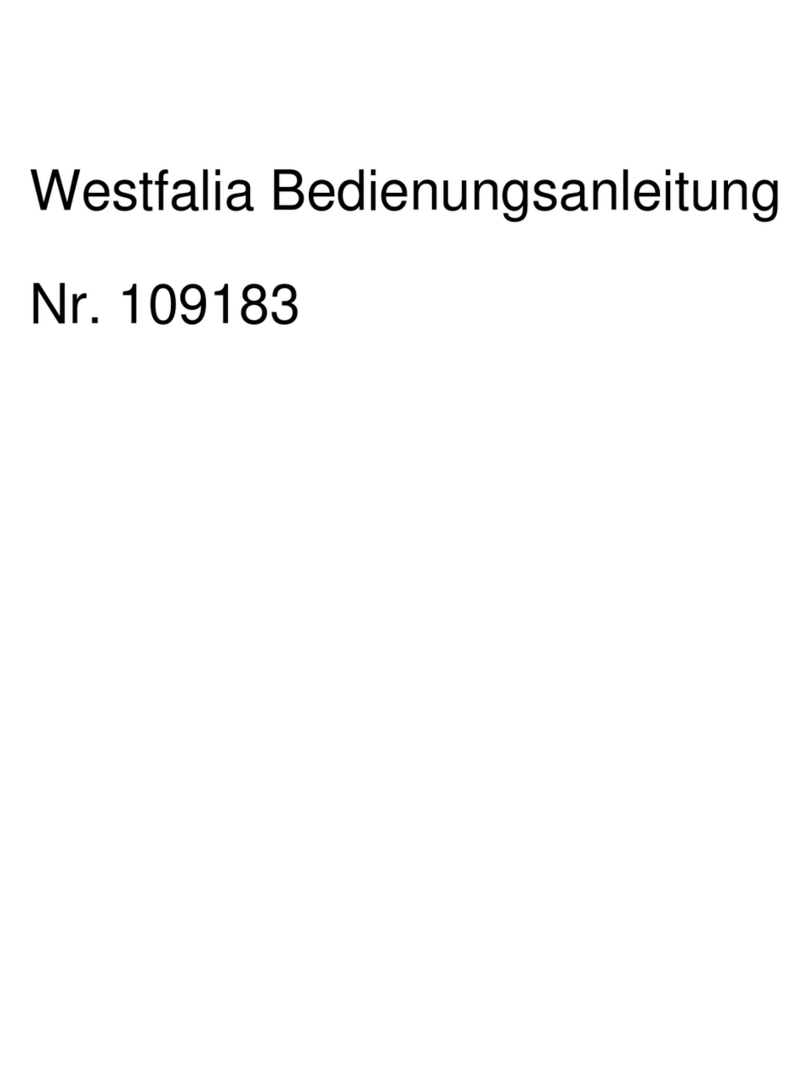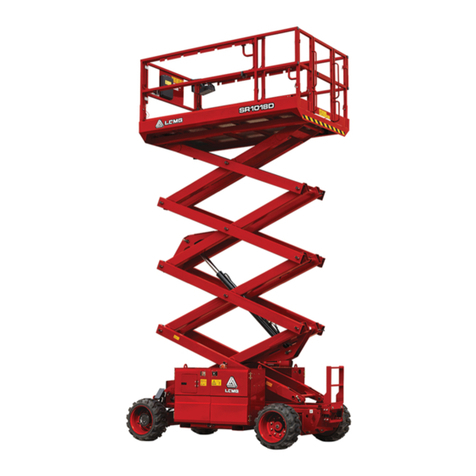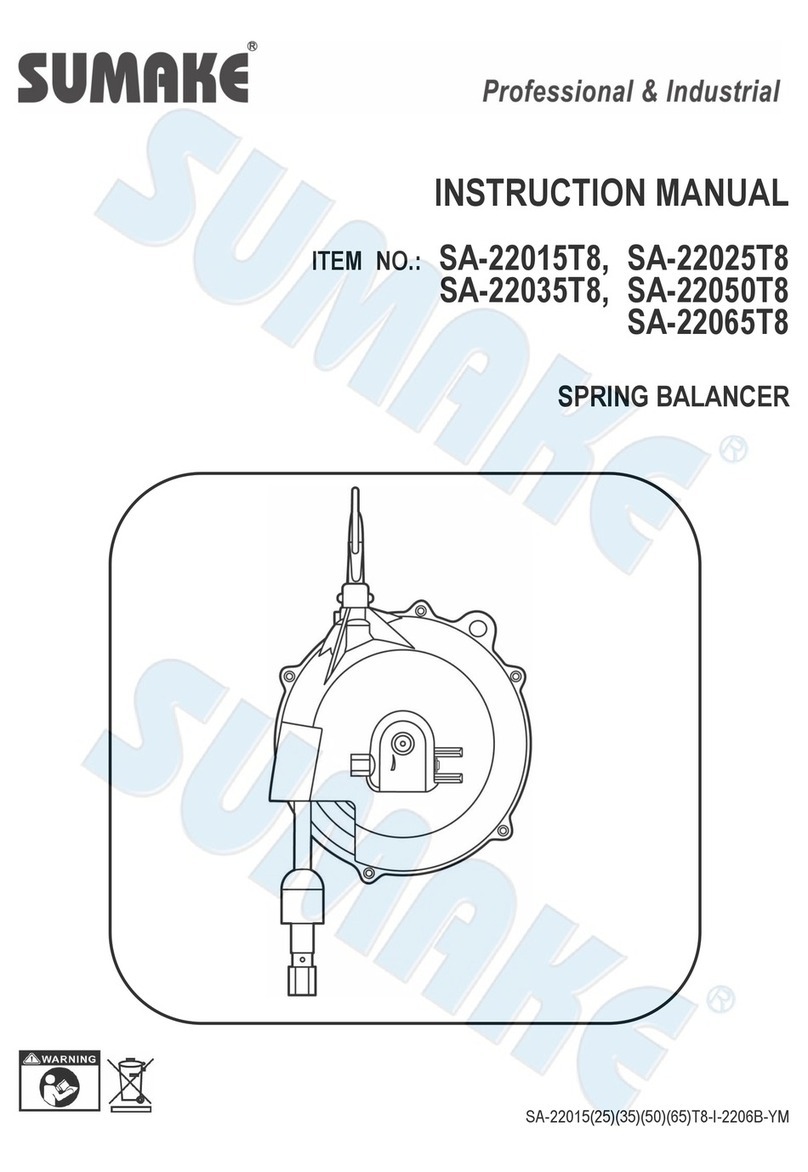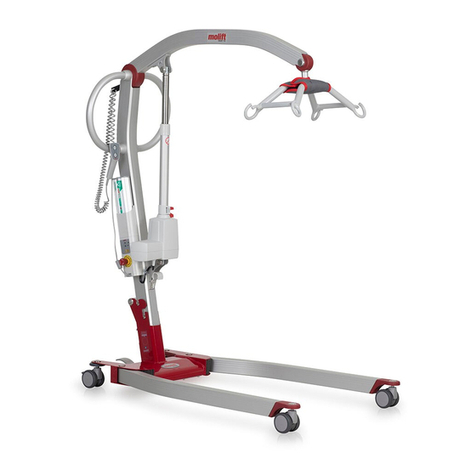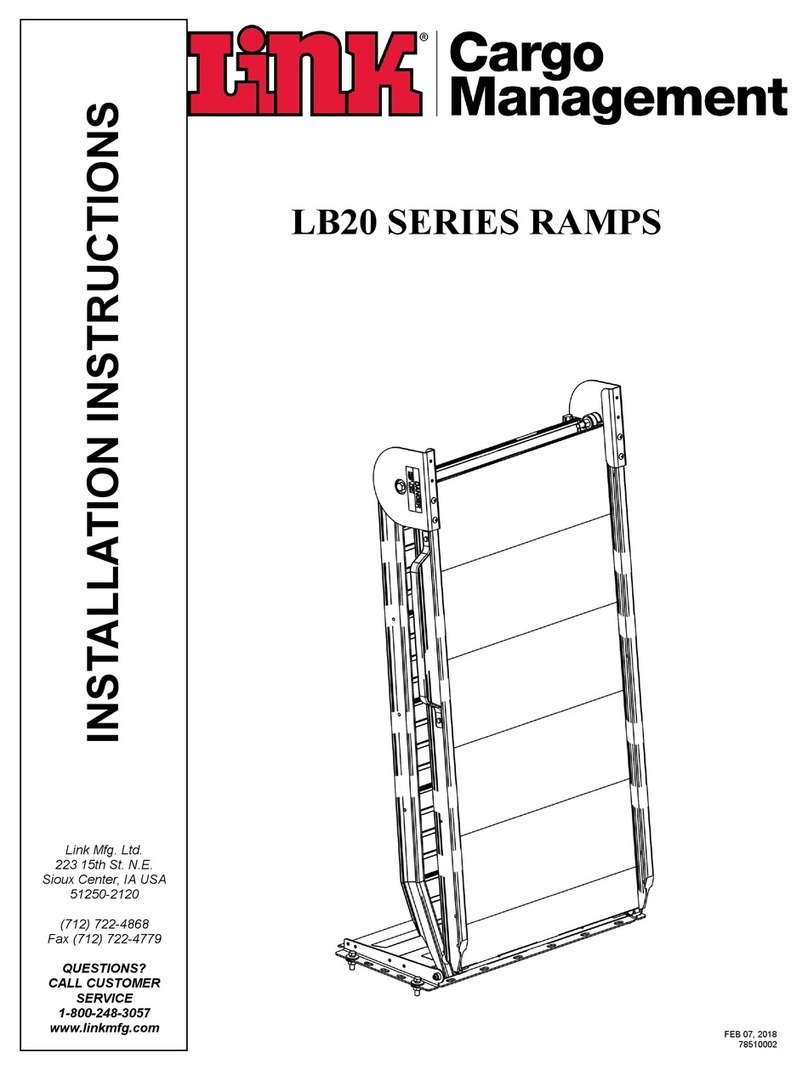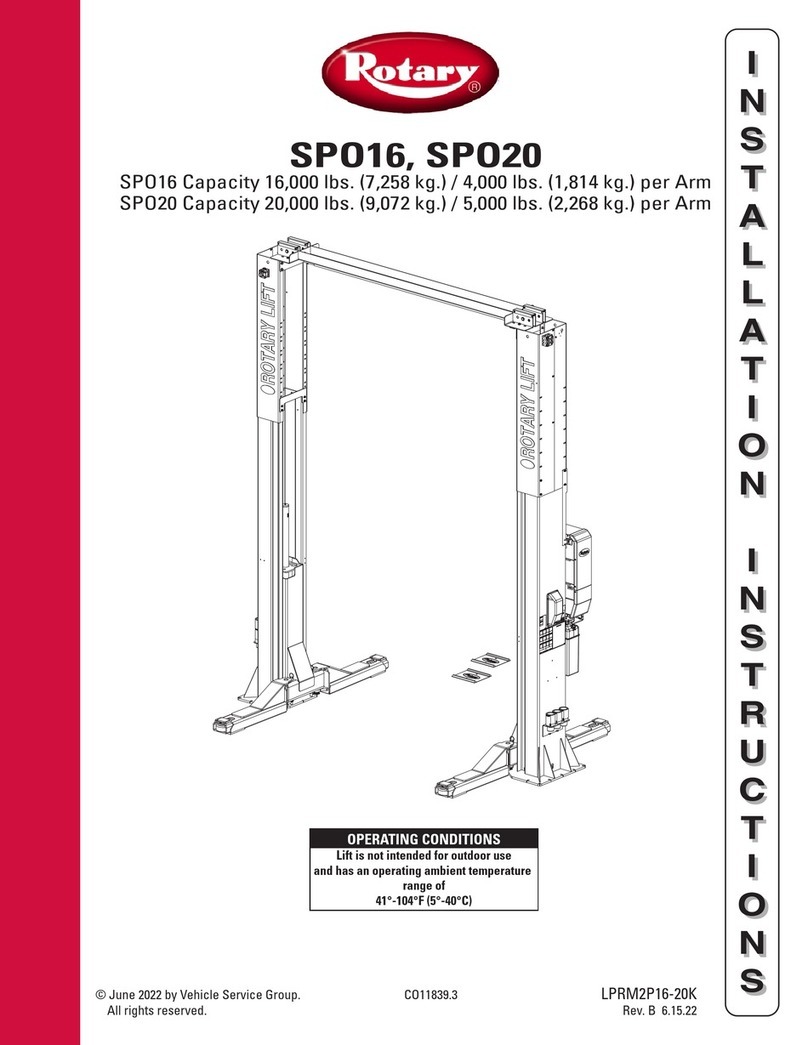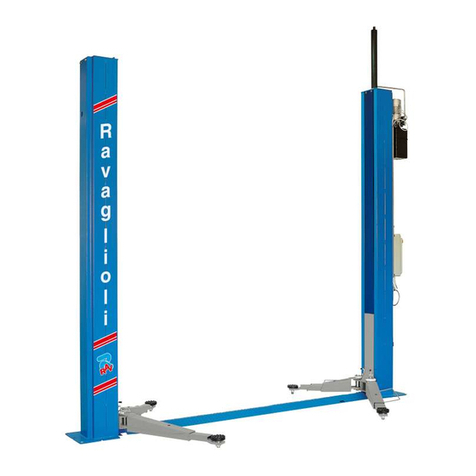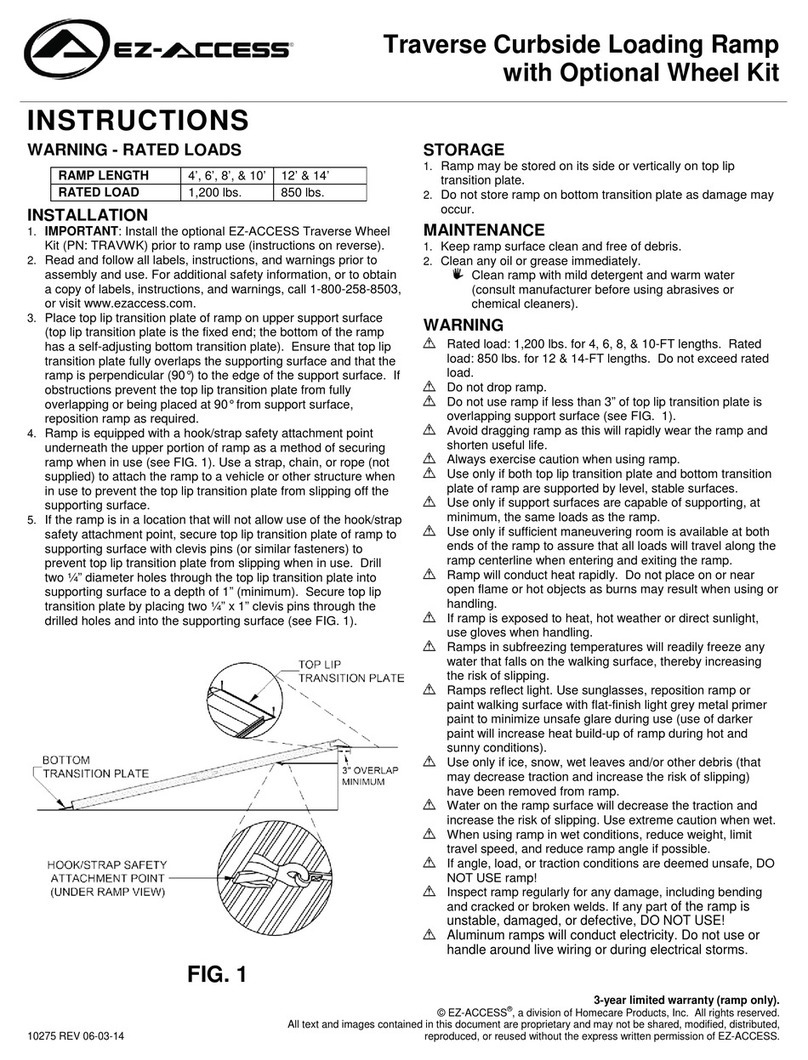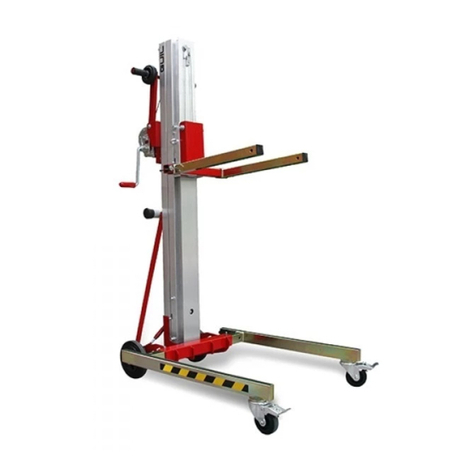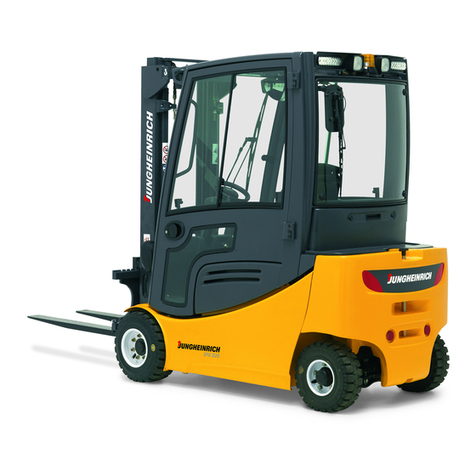Glomstad Motor GM-6150H User manual

Please read through this manual before operation. You must read and understand the
precautions for safety to protect your safety
and any damage to your property.
ELECTRO-HYDRAULIC 2-POST LIFT
Installation/Operation & Maintenance Manual
Version: GM201408.1.0
MODEL: GM -6150H

NOTE TO THE USER
Thank you for purchasing our products.
Please read this instruction carefully for safe and proper use
of the car lift, and keep it handy for future reference.
■ This Manual is for model : GM - 2150H
■ As for the assurance of safety in design and construction of
car lift, read this Manual first.
■ Please make sure that this manual is delivered to end users
for their implementation of safety.
■ Don't use the car lift in a potentially explosive atmosphere.
ANY PART OF THIS PRINT MUST NOT BE REPRODUCED
IN ANY FORM WITHOUT PERMISSION.
THIS PRINT IS SUBJECT TO CHANGE WITHOUT NOTICE.

i
Installation/Operation & Maintenance Manual
GM - 6150H 2-POST LIFT
Chapter 1 DESCRIPTION OF THE MACHINE
1.1 FIXED STRUCTURE
1.2 MOVING UNITS
1.3 LIFTING UNITS
1.4 HYDRAULIC POWER UNIT
1.5 CONTROL BOX
1.6 SAFETY DEVICES
Chapter 2 TECHNICAL SPECIFICATIONS
2.1 OVERALL DIMENSIONS
2.2 ELECTRIC MOTOR
2.3 HYDRAULIC UNIT PUMP
2.4 OIL
2.5 ELECTRICAL DIAGRAM
2.6 HYDRAULIC OIL HOSE CONNECTION DIAGRAM
2.7 VEHICLE WEIGHT AND SIZE
2.8 MAXIMUN DIMENSIONS OF VEHICLES TO BE LIFTED
Chapter 3 SAFETY
3.1 GENERAL PRECAUTIONS
3.2 RISKS OF ELECTRIC SHOCK
3.3 RISKS AND PROTECTION DEVICE
3.4 LONGITUDINAL AND LATERAL MOVEMENT
3.5 RISKS WHILE THE VEHICLE IS BEING RAISED
3.6 RISKS OF PERSONS
3.7 SAFETY INSTRUCTIONS FOR SERVICING
Chapter 4 INSTALLATION
4.1 INSTALLATION REQUISITE CHECKLIST
4.2 LIGHTING
4.3 FLOOR
4.4 ASSEMBLING
4.5 TESTING AND CHECKS TO PERFORM BEFORE START-UP
4.6 SEP UP
Chapter 5 OPERATIONS AND USE
5.1 COMMANDS
5.2 OPERATING SEQUENCE
TABLE OF CONTENTS
1
1
1
2
2
2
2
3
3
3
3
4
4
4
5
5
6
6
7
7
7
8
9
11
12
12
12
13
13
15
16
17
17
17
TABLE OF CONTENTS

ii
Installation/Operation & Maintenance Manual
GM - 6150H 2-POST LIFT
Chapter 6 MAINTENANCE
6.1 PRECAUTIONS
6.2 PERIODIC MAINTENANCE
6.3 PERIODIC LUBRICATION CHART
Chapter 7 TROUBLESHOOTING
7.1 TROUBLE SHOOTING GUIDE
7.2 POSSIBLE PROBLEMS AND SOLUTIONS
APPENDIX A SPECIAL NOTES
APPENDIX B SPARE PARTS
18
18
18
20
21
21
21
22
22
TABLE OF CONTENTS

1
Installation/Operation & Maintenance Manual
GM - 6150H 2-POST LIFT
Chapter 1 DESCRIPTION OF THE
MACHINE
The electro-hydraulic 2-post lift is a fixed installation.
This means that it is anchored to the ground and
built for lifting and positioning automobiles and vans
at a certain height off the ground.
The lift consists of the following main parts:
◆ Fixed structure (posts);
◆ Moving units (carriages + arms);
◆ Lifting units (hydraulic cylinders + power unit);
◆ Safety devices.
Fig. 1 illustrates the working areas reserved for use
by operators around the lift.
Fig. 1
◆ Command side: this side of the lift includes the
area reserved for operators to access the
control box.
◆ Service side: this is the opposite side of the
command side.
◆ Front side: the side with the short arms.
◆ Rear side: the side with the long arms.
Fig. 2 illustrates the various parts of the lift.
Fig. 2
1.1 FIXED STRUCTURE
The structure consists of:
◆ 2 posts, (service (Fig. 2-1) and command (Fig.
2-10) side post) built with bent steel plate. The
base is welded to a drilled plate to be anchored
to the floor. The hydraulic power unit (Fig. 2-7)
are attached to the command post. Inside each
post are the moving parts to lift the vehicles.
◆ The column set on the base.
1.2 MOVING UNITS
Each unit consists of:
◆ Both carriage (Fig. 2-3 and Fig. 2-6) built with
welded steel plate. It joints by chain (Fig. 2-2)
and the cable (Fig. 2-9), and at the bottom to
the lift arms by means of pins.
◆ The carriage moves along the post, guided by
plastic sliding pads, located inside the post
itself.
◆ Two telescopic arms, one long and one short
(Fig. 2-4), built with tubular steel with a pad at
each end that can be height adjusted to hold
the car and on the opposite side the carriage
connection hole.
1.3 LIFTING UNIT

2
Installation/Operation & Maintenance Manual
GM - 6150H 2-POST LIFT
It consists of:
◆ 2 hydraulic cylinders (Fig. 2-8), the carriages
run by chains and synchronized by steel cables.
◆ 1 hydraulic unit (Fig. 2-7), on the command
side, to set the cylinders run.
1.4 HYDRAULIC POWER UNIT
The hydraulic power unit consists of:
◆ An electric motor (Fig. 3-1);
◆ A geared hydraulic pump (Fig. 3-2);
◆ Descent hand-valve equipped with a manual oil
drain valve; (Fig. 3-3) (see the use and
maintenance chapter)
◆ A maximum pressure valve;
◆ Oil tank (Fig. 3-4);
◆ An oil delivery and return flexible pipe to the
cylinders feeding circuit.
Note: The oil delivery pipe may be under
pressure.
Fig. 3 Hydraulic Power Unit
1.6 SAFETY DEVICES
The safety devices include:
◆ Mechanical safety device for carriage;
◆ Arms locking system;
◆ 4 foot guards on the arms;
◆ A synchronous device to control the carriages
movement;
◆ End limit switch;
◆ General electric safety devices;
◆ General hydraulic safety devices.
These safety devices will be described in further
detail in the following chapters.

3
Installation/Operation & Maintenance Manual
GM - 6150H 2-POST LIFT
Chapter 2 TECHNICAL
SPECIFICATIONS
2.1 OVERALL DIMENSIONS
Fig. 4
Table 1
2.2 ELECTRIC MOTOR
Table 2
The motor must be connected with reference to the
attached wiring diagrams.
The motor rotation direction must be the same as
shown by the arrow on the pump: if not, modify the
electrical connections. (see Chapter 4
INSTALLATION- E L E C T R I C P L A N T
CONNECTION)
2.3 HYDRAULIC UNIT PUMP
Table 3
2.4 OIL
Model No.
Capacity 5,000kg
Overall Height 2824mm
Overall Width 3384mm
Min. Height 100mm
Max. Lifting Height 1880mm
Width between Columns 2760mm
Short Arm Length 685~1050mm
Long Arm Length 845~1300mm
Lifting Time ≤60s
Lowering Time ≤40s
Three-phase Single phase
Power 2.2KW 2.2KW
Voltage 230-400V 3ph
+/-5%
230V 1ph
+/-5%
Frequency 50Hz 50Hz
Absorption 230V: 11A
400V: 6.4A 13A
N° of poles 4
Speed 1400r.p.m. 1380r.p.m.
Construction B14
Insulation
class IP54 IP54
Type 90L4 90L4
MOTOR
3Ph 1Ph
Type R T
Model PHC PHC
Size 7.8cm3/g 6.0cm3/g
Transmission: coupling
type E32 E32
Continuous operating
pressure 160bar 150bar
Max. operating pressure
(peak) 180bar 170bar
GM - 6150H

4
Installation/Operation & Maintenance Manual
GM - 6150H 2-POST LIFT
The oil reservoir contains hydraulic mineral oil in
accordance with ISO/DIN 6743/4 with a level of
contamination that does not exceed class 18/15
according to ISO 4406, for example IP HYDRUS
OIL 32, SHELL TELLUS OIL T32 or equivalent.
2.5 ELECTRICAL DIAGRAM
Fig. 5 1Ph Electrical Diagram
Fig. 6 3Ph Electrical Diagram
Table 4
2.6 HYDRAULIC OIL HOSE CONNECTION
DIAGRAM
Fig. 7
Table 5
CODE DESCRIPTION
Q Circuit Breaker
SB1 Lift Button
SQ1 Limit Switch
KM AC Contactor
8
7
65
4
3
D
10
9
2
1
S/N DESCRIPTION
1 Lock valve
2 Operating Cylinder with simple effect
3 Manual lowering valve
4 Check valve
5 Motor
6 Pump
7 Filter
8 Pressure relief valve
9 Flow control valve
10 Tank

5
Installation/Operation & Maintenance Manual
GM - 6150H 2-POST LIFT
2.7 VEHICLE WEIGHT AND SIZE
Lift rack can be adapted to virtually all vehicles no
heavier than 5000kg, the dimensions of which do
not exceed the following:
Max width: 2400mm
Max wheelbase: 3000mm
2.8 MAXIMUM DIMENSIONS OF VEHICLES
TO BE LIFTED
The underbody of cars with low ground
clearance may interfere with the structure of the
lift. Pay particular attention in the case of low
body sports cars.
Always keep the capacity of the lift in mind in
the case of vehicles with particular
characteristics.
THE SAFETY area will be determined by the
dimensions of the vehicle.
The diagrams below include the criteria for defining
the limits of use of the carrack.
Fig. 8
CHECK MAXIMUM LOAD CAPACITY AND LOAD
DISTRIBUTION IN CASE OF LARGER VEHICLES.
MAXIMUM WEIGHT OF THE VEHICLE TO BE
LIFTED SHOULD NOT BE OVER 4,000KG.
Fig. 9 Weight Distribution
1600 2400
MAX.4000kg.!
5000kg
2000 3000

6
Installation/Operation & Maintenance Manual
GM - 6150H 2-POST LIFT
Chapter 3 SAFETY
It is vital to read this chapter of the manual carefully
and from beginning to end as it contains important
information regarding the risks that the operator and
the maintenance fitter may be exposed to in the
eventuality that the lift is used incorrectly.
The following text contains clear explanations
regarding certain situations of risk or danger that
may arise during the operation or maintenance of
the lift, the safety devices installed and the correct
use of such systems, residual risks and operative
procedures to use (general and specific precautions
to eliminate potential hazards).
WARNING
Lift is designed and built to lift vehicles and hold
them in the elevated position in a closed workshop.
All other uses are unauthorized; in particular, the lift
is not suitable for:
◆ Washing and respire work;
◆ Creating raised platforms or lifting personnel;
◆ Use as a makeshift press for crushing purpose;
◆ Use as goods lift
◆ Use as a jack for lifting vehicles or changing
wheels.
THE MANUFACTURE DISCLAIMS ALL LIABILITY
FOR INJURY TO PERSONS OR DAMAGE TO
VEHICLES AND OTHER PCABLERTY CAUSED
BY THE INCORRECT AND UNAUTHORISED USE
OF THE LIFT.
During lift and descent movements, the operator
must remain in the command station as defined in
figure 8. The presence of persons inside the danger
zone indicated in the same figure is strictly
prohibited. The presence of persons beneath the
vehicle during operations is permitted only when the
vehicle is parked in the elevated position.
DO NOT USE THE LIFT WITHOUT PROTECTION
DEVICES OR WITH THE PROTECTION DEVICES
INHIBITED. FAILURE TO COMPLY WITH THESE
REGULATIONS CAN CAUSE SERIOUS INJURY
TO PERSONS, AND IRREPERABLE DAMAGE TO
THE LIFT AND THE VEHICLE BEING LIFTED.
Fig. 10 Working Area
3.1 GENERAL PRECAUTIONS
The operator and the maintenance fitter are required
to observe the prescriptions of accident prevention
legislation in force in the country of installation of the
lift.
Furthermore, the operator and the maintenance fitter
must:
◆ Always work in the scheduled working area as
shown in the manual;
◆ Never remove or deactivate the guards and
mechanical, electrical, or other types of safety
devices;
◆ Read the safety notices affixed to the machine
and the safety information in this manual.
In the manual all safety notices are shown as
follows:
DANGER: indicates imminent danger that can result
in serious injury or death.
WARNING: indicates situations and/or types of
maneuvers that are unsafe and can cause injuries of
various degrees or death.

7
Installation/Operation & Maintenance Manual
GM - 6150H 2-POST LIFT
CAUTION: indicates situations and/or types of
maneuvers that are unsafe and can cause minor
injury to persons and/or damage the lift, the vehicle
or other psaltery.
3.2 RISKS OF ELECTRIC SHOCK
Specific safety notice affixed to the lift in areas
where the risk of electric shock is particularly high.
3.3 RISKS AND PROTECTION DEVICE
We shall now examine the risks to which the
operator and the maintenance fitters may be
exposed when the vehicle is immobilized in the
raised position, together with the protection devices
and adopted by the manufacture to reduce all such
hazards to the minimum.
3.4 LONGITUDINAL AND LATERAL
MOVEMENT
Longitudinal movement is considered the backward
and forward shifting of the load.
Lateral movement implies the shifting to the left or
right of the vehicle, especially during the lifting
phase on the rack.
These movements can be avoided by positioning
the vehicle correctly on the arm disk support plates,
which must be previously adjusted to the same
height (by loosening or tightening) as the vehicle.
Do not move the vehicle in relation to the arms or
adjust arms and disk support plates until the arms
have been totally lowered, i.e. the disk support
plates must be free from all contact with the vehicle.
Fig. 11 Risk of Vehicle Fall
WARNING
DO NOT ATTEMPT TO MOVE THE VEHICLE
WHEN IT IS RESTING ON THE DISK SUPPORT
PLATES.
It is important to position the vehicle on the lift so
that the weight is correctly distributed on the arms.
(Fig. 12) For person and equipment safety, it is
important that:
◆ People rest inside the safety area while the
vehicle raising. (Fig. 10)
◆ The engine is off, the clutch engaged and the
parking brake pulled.
◆ The vehicle is correctly positioned. (Fig. 12)
◆ Only authorized vehicle (Fig. 8 & Fig. 9) are
raised without exceeding the rate capacity and
overall dimensions.

8
Installation/Operation & Maintenance Manual
GM - 6150H 2-POST LIFT
Fig. 12 Correctly Loaded Vehicle
3.5 RISKS WHILE THE VEHICLE IS BEING
RAISED
The following safety devices have been installed to
protect against overweight conditions and
equipment failure:
◆ The thermal relay in the electric box will trip if
the motor is overloaded.
◆ The maximum pressure valve (Fig. 13), located
on the hydraulic oil power unit, will trip if the lift
is overloaded.
Fig. 13
◆ If the lift reaches to the maximum height, the up
limit switch will stop the lifting. (Fig.14)
Fig. 14
◆ Keep both cables in balance during raising or
lowering. (Fig. 15)
Fig. 15
◆ If the hydraulic cylinder breaks, the safety
wedges will trip (Fig. 16), located inside the
posts. The wedges are pushed by the spring
and immediately stop the carriage preventing
their descent.
Fig. 16

9
Installation/Operation & Maintenance Manual
GM - 6150H 2-POST LIFT
◆ If the moving part exceed its travel distance, on
the upper part of the command post there is
one limit switch and is usually set working by
the “actuator” (Fig. 14) on the command side
carriage. If the first limit switch did not work, the
second one would trip after 3sec of carriage
run.
◆ In case of total breakdown of the limit switches,
the carriage will stop a few millimeter higher.
Because the hydraulic cylinders come to end
stroke, will cause the maximum pressure valve
(on hydraulic unit) to trip.
3.6 RISKS OF PERSONS
This paragraph illustrates risks to which the
operator, maintenance worker, or any person near
the operating area of the lift may be exposed in the
case of impeccable use of equipment.
3.6.1 RISK OF CRUSHING (OPEARATOR)
Possible if the operator controlling the lift is not in
the specified position at the command panel. When
the platform and the vehicle are descending, the
operator must never be partly or completely
underneath the moving structure. During this phase,
the operator must remain in the command zone.
(Fig. 17)
Fig. 17
3.6.2 RISK OF CRUSHING (PERSONNEL)
When the platform and the vehicle are descending,
personnel are prohibited from entering the area
beneath the moving parts of the lift. (Fig. 18) The lift
operator must not start the maneuver until it has
been clearly established that there are no persons in
potentially dangerous positions.
Fig. 18
3.6.3 RISK OF IMPACT
Caused by the parts of the lift or the vehicle that are
positioned at head height. When, due to operational
reasons, the lift is immobilized at relatively low
elevations (less than 1.75m from the ground)
personnel must be careful to avoid impact with parts
of the machine not marked with special hazard
coloring. (Fig. 19)
Fig. 19
3.6.4 RISK DUE TO VEHICLE MOVEMENT
Movement may be caused during operations, which
involve force sufficient to move the vehicle. (Fig. 20)
If the vehicle is of considerable dimensions or
weight, movement may lead to overload or
unbalancing. All measures must be taking to avoid
such an occurrence.

10
Installation/Operation & Maintenance Manual
GM - 6150H 2-POST LIFT
Fig. 20
3.6.5 RISK OF VEHICLE FALLING FROM LIFT
This risk could be caused by the incorrect
positioning on the arm disk support plates (Fig. 21)
or in incorrect position of the arm disk support plates
in relation to the lift.
Fig. 21
NEVER BOARD THE VEHICLE AND/OR TURN
THE ENGINE ON WHEN LIFT IS RAISED. (Fig. 22)
Fig. 22
NEVER LEAN OBJECTS AGAINST THE POSTS
OR LEAVE THEM IN THE AREA WHERE MOVING
PARTS ARE LOWERED.
This could hamper lowering or cause the vehicle to
fall from the rack. (Fig. 23)
Fig. 23
3.6.6 SLIPPING
This risk may arise due to spillage of lubricants in
the surrounding area. (Fig. 24)
Fig. 24
ALWAYS KEEP THE AREA SURROUNDING AND
THE LIFT CLEAN BY REMOVING ALL OIL
SPILLS.
To avoid the risk of slipping, make use of the
recommended personal protection (anti-slip
footwear).
3.6.7 RISK OF ELECTRIC SHOCK
Risk of electric shock in areas of the lift housing
electric wiring. Do not use jets of water, steam (high
pressure wash units), and solvents or paint in the
immediate vicinity of the lift, and take special care to
keep such substances clear off the electrical
command panel. (Fig. 25)

11
Installation/Operation & Maintenance Manual
GM - 6150H 2-POST LIFT
Fig. 25
3.6.8 RISK OF COMPONENT FAILURE DURING
OPERATION
The manufacturer has used appropriate materials
and construction techniques in relation to the
specified use of the machine in order to manufacture
a reliable and safe lift. Note, however, that the lift
must be used in conformity with the manufacturers
prescriptions and the frequency of inspections and
maintenance work recommended in Chapter 6
“MAINTENANCE” must be observed.
3.6.9 RISK RELATED TO IMPROPER USE
Persons are not permitted to stand or sit on the
platforms during the lift maneuver or when the
vehicle is already lifted. (Fig. 26) All uses of the lift
other than the uses for which it was designed are
liable to give rise to serious accidents involving the
persons working in the immediate vicinity of the unit.
It is therefore essential to adhere scrupulously to all
regulations regarding use, maintenance and safety
contained in this manual.
Fig. 26
3.7 SAFETY INSTRUCTINS FOR
SERVICING
◆ Maintenance or repair work by authorized
service personnel only.
◆ Turn off and padlock the main switch before
doing any maintenance, or repair work.
◆ Work on pulse generators or proximity switches
by authorized service personnel only.
◆ Work on the electrical equipment by certified
electricians only.
◆ Do not replace or override the safety devices.
◆ Ensure that ecologically harmful substances are
disposed of only in accordance with the
appropriate regulations.

12
Installation/Operation & Maintenance Manual
GM - 6150H 2-POST LIFT
Chapter 4 INSTALLATION
THE FOLLOWING OPERATIONS MUST BE
PERFORMED EXCLUSIVELY BY SPECIALISED
TECHNICAL STAFF WITH AUTHORISATION
FROM THE MANUFACTURER OR LICENSED
DEALER. IF THESE OPREATIONS ARE
PERFORMED BY OTHER PERSONS, SERIOUS
PERSONAL INJURY AND/OR IRREPERABL
DAMAGE TO THE LIFT UNIT MAY RESULT.
4.1 INSTALLATION REQUISITE
CHECKLIST
The lift is designed for installation in enclosed areas
suitably protected from the weather. The place of
installation must be well clear of areas destined to
washing or painting, and away from solvent or paint
storage areas or areas where there is a risk of
potentially explosive atmosphere.
SUITABILITY OF THE DIMENSIONS OF THE
PLACE OF INSTALLATION AND SAFTY
CLEARANCE.
The lift must be installed in observance of the
clearances between walls, pillars, other machines,
etc. indicated in Fig. 27 and incompliance with any
legislative requirements in the county of installation.
Check in particular:
◆ Minimum height: 5000mm inclusive of height
of vehicle, maximum height of arms, (i.e.
1900mm), and upper post height (i.e. 2828mm)
◆ Min. distance from walls: 600mm
◆ Min. working area: 700mm
◆ Area for command station
◆ Area for maintenance, access and emergency
escape routes.
◆ Position in relation to other machines
◆ Proximity to power supply for trouble-free hook-
up
Fig. 27
Fig. 28
4.2 LIGHTING
All parts of the machine must be uniformly lit with
sufficient light to assure that the adjustment and
maintenance operations specified in the manual can
be performed, and without areas of shadow
reflected light, glare and avoiding all situations that
could give rise to eye fatigue.
The lighting must be installed in accordance with the
laws in force in the place of installation
(responsibility lies with the lighting equipment fitter).

13
Installation/Operation & Maintenance Manual
GM - 6150H 2-POST LIFT
4.3 FLOOR
The lift must be installed on a horizontal concrete
bed with a minimum thickness of 200mm built and a
resistance ≥30N/mm2.
The floor must also be flat and level (10mm of
tolerance for leveling). Consult the manufacturer
with regard to special applications.
Fig. 29
4.4 ASSEMBLING
WARNING
DURING INSTALLATION ONLY AUTHORISED
PERSONNEL IS ALLOWED.
To assemble the lift, the weight of the various parts
is to be considered, in order to provide a lifting
machine with the minimum capacity 500kg and max.
lifting height of 2900mm.
Before starting to assemble the lift, check the crate
contains all the needed material.
4.4.1 POST ASSEMBLING
◆ Install both boards on the bases, keep the main
column upright, and put the stiffs which are no
less than 100mm on the upside for the
convenience of installing the safety device,
cable, hose and wire.
◆ Install the balance cable according to Fig. 30.
The cable also can be crossed from the hole on
the board before the fixing of both columns.
Fig. 30
◆ Connect the high-pressure hose according to
Fig. 31. First connect the hose with tri-joint
under the main column and the bend under the
sub-column. Fix them after upright the columns.
Fig. 31
◆ Hold up both columns (keep the carriage lock
and in the same level), and then fix the bolts on
the base.
◆ Install the safety devices.

14
Installation/Operation & Maintenance Manual
GM - 6150H 2-POST LIFT
◆ Adjust both cables and keep the carriage in
balance.
◆ Screw the joint of the high-pressure hose and
fix it on the base.
4.4.2 HYDRAULIC PALNT
◆ Install the pump on the hock board according to
Fig. 32 and fix it on the bottom of main column.
Fig. 32
◆ Connect the hydraulic unit to the circuit crossing
with a flexible pipe. (Fig. 33)
Fig. 33
◆ Tight all the fittings very well, even the one
already mounted by the manufacturer.
◆ Fill the hydraulic unit tank with 8 liters of
hydraulic oil ISO 32 as IP HYDRUS OIL 32,
SHELL TELLUS OIL T32 or similar (See
Chapter 2, TECHNICAL SPECIFICATIONS).
◆ Remove the oil filling cap and substitute it with
the given drain cap.
4.4.3 ELECTRIC PLANT CONNECTION
WARNING
The operations listed below must be performed
by skilled personnel.
4.4.3.1 Before connecting the electric system, make
sure that:
◆ The power supply plant to the lift is equipped
with the protection device required by current
standards in the country where the machinery is
installed.
◆ The power supply line has the following cross-
section:
Lift voltage 400V, three-phase………….……Min.
2.5mm2
Lift voltage 230V, three-phase…………………Min.
4mm2
Lift voltage 230V, single-phase……………..…Min.
6mm2
◆ The voltage oscillations are within the tolerance
range set forth by the specifications.
The manufacturer supplies the rack to operate at
400V with a three-phase configuration; if the line
voltage is different, the motor and transformer
connection must be changed. (Fig. 33) It is also
necessary to replace the thermal relay requesting
that part from the manufacture and/or service
center.
Fig. 34
4.4.3.2 Connect the power supply cable and end
limit switch wire to the terminal strip on the junction
W2 U2 V2
W1V1U1
L1 L2 L3
U2W2 V2
W1V1U1
L3L2L1
Motor
0 0 24
Trasformer

15
Installation/Operation & Maintenance Manual
GM - 6150H 2-POST LIFT
box of the motor (Fig. 35) following the wiring
diagram on Page 4.
Fig. 35
4.4.3.3 The wires should be fixed by nylon pitch.
4.4.3.4 Close the cover of the junction box. Press
the up push button (Fig. 35), the motor rotation
direction should be the one shown by the arrow on
the pump.
BEWARE: The pump rotating for a long time in
the wrong sense may cause itself serious
damages.
4.4.3.5 Make sure that the post end limit switch work
properly by pressing them manually.
4.4.4 ARM ASSEMBLING
◆ Press the up push button, raise the carriages to
a height of about 70cm off the ground, then
press the manual lowering lever until the
carriages rest on the safety wedge. CUT OFF
THE POWER SUPPLY TO THE LIFT.
◆ Grease the holes φ40 on the arms ends.
◆ Mount the arms into the carriage supports and
insert the dowel pins into the support holes as
shown in Fig. 36. Notice the entry of both arms
is the same with the entry of the vehicle.
Fig. 36
◆ Block the spring ring at the end of the pin.
WARNING
End-user should confirm that the over load
device must be connected before the electrical
power connected to lift.
4.4.5 INSTALL THE COVER PLATE
Install the cover plates at the chassis by 4 pieces
M8×16 bolts.
4.4.6 INSTALL SPRING SCREW
◆ Make 14 drills on the basement with a helical
concrete bit with a diameter of 18mm to a depth
to 130mm. Use the basis pad as a drilling
template.
◆ Install the screw according to Fig. 29.
4.5 TESTING AND CHECKS TO PERFORM
BEFORE START-UP
4.5.1 MECHANIAL TESTS
◆ Attachment and tightness of bolts, fittings and
connections
◆ Free sliding of moving parts
◆ Clean state of various parts of the machine
◆ Position of the protection device
◆ Arms blocking device

16
Installation/Operation & Maintenance Manual
GM - 6150H 2-POST LIFT
4.5.2 ELECTRIC TESTS
◆ Connection comply with diagrams
◆ Machine earth connections
4.5.3 OPERATING OF THE FOLLOWING
DEVICES
◆ Rise limit switch
◆ Manual lowering valve
4.5.4 HYDRAULIC OIL TEST
◆ Sufficient oil in the tank
◆ No leaks
◆ Cylinder operation
NOTE: If oil is not present, fill the reservoir of
the power unit with the necessary amount of
oil .See the procedure in Chapter 6:
MAINTENANCE
4.5.5 ROTATION DIRECTION TEST
The motor should turn in the direction of the arrow
located on the power unit pump; check using brief
start-ups (each start-up must last a maximum of two
seconds). If problems arise in the hydraulic oil plant,
see the “Trouble-shooting” table in Chapter 7.
4.6 SET UP
WARNING
THESE OPERATIONS MUST ALWAYS BE
PERFORMED BY TECHNICIONS OF THE
AUTRORIZ SERVICE CENTRE INDICATED IN
THE FRONT OF THIS MANUAL.
4.6.1 NO-LOAD TESTS
In this phase check the following:
◆ That the up button and lowering lever operate
correctly;
◆ That the rack reaches the maximum height;
◆ That there are no abnormal vibrations in the
posts and in the arms;
◆ That the safety wedges enter the iron pads
under the carriage;
◆ That the rise limit switches trip;
◆ That the safety wedges trip;
◆ After having done all as previously
recommended, the height difference between
the arms of the two carriages, is less than 1cm.
On the contrary, adjust their level by working on
the counter nuts on the synchronous steel
cables.
To perform the tests listed about, complete two or
three complete up and down cycles. This is also to
be done in order to make the air in the hydraulic
circuit going out.
4.6.2 LOAD TESTS
Repeat the previous tests with the vehicle on the
rack.
After the load tests, visually inspect the machinery
and check again that all bolts are tightened.
This manual suits for next models
1
Table of contents
Other Glomstad Motor Lifting System manuals
